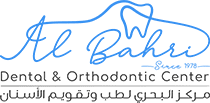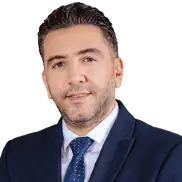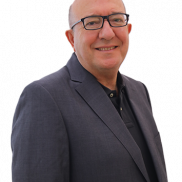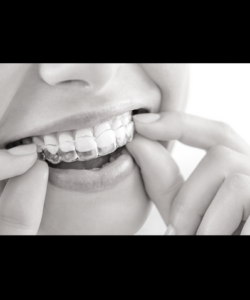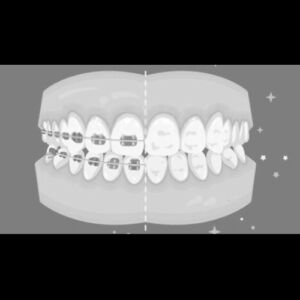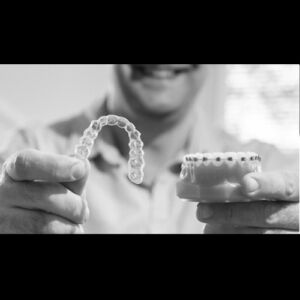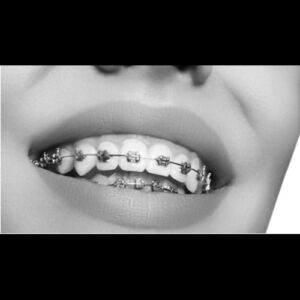Orthodontist in Abu Dhabi
To straighten and align teeth, dentists use braces for their patients. Braces correct several orthodontic malocclusions and prevent further issues down the 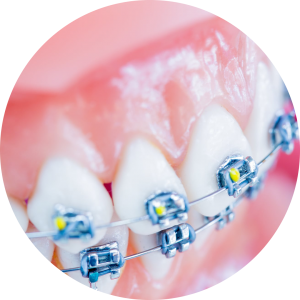

Twelve years of age is the recommended age to intiate treatment with braces. They are more effective in children, even though many adults are getting braces to correct their bite, too.
Oral hygiene is very essential when wearing braces because food can easily get trapped between them, leading to tooth decay. Chewy and sticky foods need to be avoided, and when the braces are first fitted, it will be painful to bite till the mouth adjusts, so patients are advised to eat soft foods or finely chopped.
There are multiple different options when it comes to braces, it depends on the complexity of the case. The brackets could be conventional metal or ceramic, the brackets could also be on the facial side or lingual, which is the back side of the teeth. As well as Invisalign which are clear retainers that also cause orthodontic movements.
The usual duration for braces is between 6 to 24 months, during which the orthodontist adjusts them once every 4 or 6 weeks. Patients willing to travel for this treatment need to have a dentist at home for follow-up care.
Treatment Preparation
Recommended for
- Crooked teeth (Malocclusions)
- Overcrowding
- Deep bites
- Overbites
Before
The brackets would be bonded onto the teeth after the patient’s impressions are taken. The duration and type of treatment are then determined after treatment planning the case. Documentation through photographs and radiographs would be taken before the treatment begins and as the case continues in order to keep track of the progression of the case.
How
With traditional stainless-steel brackets, an adhesive is first placed on the teeth and the brackets are then applied to the teeth individually. A wire is then fitted through the brackets and fixed into place with elastics. Treatment varies, but for most patients, they will need to visit the orthodontist responsible for their treatment every 4 to 6 weeks to have the braces tightened and readjusted.
Treatment Details
Materials
Traditionally, braces are made from stainless steel or stainless steel with titanium, however, nowadays there is a high demand for cosmetic braces. As a result, many dentists offer “ceramic” brackets or clear plastic aligners such as Invisalign. Lingual braces are another popular choice, as efficient as the traditional braces, but they are not easy to see as they are applied to the reverse side of the tooth (the lingual side, facing the tongue).
Anesthesia
No anesthesia required.
What to expect
Post procedure care
It is important that patients follow all instructions from their orthodontist. If patients are not compliant with the elastics or retainers, there may be relapse of the teeth.
It is important to maintain excellent oral hygiene while the braces are bonded as food can easily get stuck in the braces.
Once the treatment is finished, patients will need to wear a retainer afterwards to maintain the new position of the teeth.
Braces apply a constant pressure on the teeth, therefore discomfort is expected. Discomfort is usually highest immediately after a tightening appointment but would gradually improve afterwards.
Important to Know
Potential risks
- Root resorption and another root damage
- Periodontitis
- Gingivitis (Gum disease)
- Tooth Caries (decay)
- Gingival overgrowth
Relapse of teeth into initial position after treatment


Having a perfect set of teeth is a blessing only a few are born with, but that doesn’t mean perfect teeth cannot be achieved through careful and expert consultation. Abu Dhabi’s orthodontists are some of the best in the world, any form of irregularity of the teeth or jaw can be treated here.
Services under orthodontics
It is a general misconception that orthodontics is nothing but braces. Although treating misaligned teeth and Oral hygiene is a big part of the services provided by orthodontists in Al Ain, it is not the only one.
The following are some of the services we provide at Al Bahri:
Misaligned teeth
The most obvious job that Dubai orthodontist has is diagnosing and correcting anomalies, which usually include crowded teeth and teeth that are misaligned.
In order to correct the alignment issues, the orthodontist subsequently creates the appliances that realign your teeth and jaws. Usually, braces are used to align these teeth.
Malocclusions
The misalignment of your jaws might result in malocclusions. Orthodontists in Al Ain are skilled in treating three different malocclusions.
Once they diagnose you, they create your braces or other tools to realign your jaws and straighten your teeth. The pressure from aligners alters the position and form of the teeth, and the jaw structure improves.
Maintaining spaces
The orthodontist also offers space fillers if your child loses their baby teeth at a young age. Fillers for empty spaces keep the teeth next to missing teeth from overgrowing and reduce the amount of room for adult teeth.
Types of appliances in orthodontics
Functional orthodontics
Abu Dhabi orthodontists use a sort of brace called a functional appliance to treat skeletal abnormalities in children who are growing. There are two types of functional appliances: permanent and detachable.
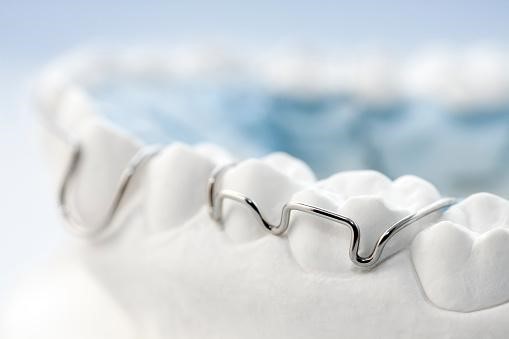

Traditional braces
It is made of premium stainless steel, and each tooth is secured with metal brackets. A thin archwire connects the brackets to one another.
Damon system
The self-ligating braces use a slide mechanism to attach wires to brackets so they can move naturally with the teeth as they realign, as opposed to the traditional braces, which have brackets that need to be tightened and adjusted on a regular basis.
Invisalign
Treatment with Invisalign is an alternative to conventional orthodontic procedures like braces. It consists of a set of practically invisible, removable aligners that must be changed every two to four weeks. Invisalign aligners gradually reposition your teeth, but you must wear them for at least 20 hours a day and practice good oral hygiene to prevent cavities from developing.
The need for treatment
In addition to their visual benefits, dental procedures like straightening crooked teeth also enhance the quality of life. Several individuals struggle to chew because of their crooked teeth. Moreover, tooth problems can cause other issues, such as headaches.
Choosing to ignore them results in additional dental problems and ongoing costs that can be reduced.
Luckily, most dental procedures don’t cause great discomfort, so they can benefit adults as well as children. The best orthodontist in Abu Dhabi recommends that problems be diagnosed as soon as possible. With early correction, the child can have a beautiful smile with perfectly aligned teeth, giving their personality more assurance.
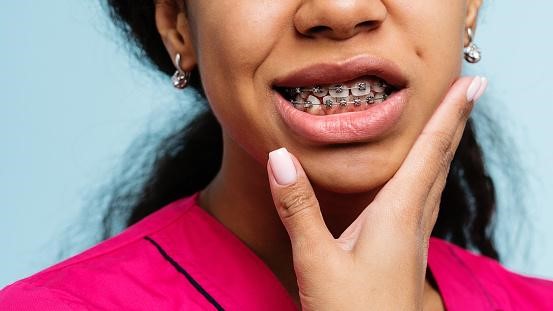

About us
The Al-Bahri Dental and Orthodontic Centre has the best orthodontists In Abu Dhabi, they deliver exceptional dental treatments, easing even the most feared procedures for our patients. They have years of experience and put the needs of our patient’s oral care at the center of everything they do.
Explore More Services!
- Dental Implants Services
- Cosmetic Dentistry Services
- Pediatric Dentistry Services
- Endodontics Services
- Laser Dentistry Services
- Restorative Dentistry Services
- Oral Surgery
- Periodontology
- Oral Hygiene Services
- Prosthodontics Services
- Dental Clinic Al Ain
Meet our Doctors
Explore More
High Innovative Technology & Professional Dentists
Make An Appointment
FAQ
It’s recommended to visit the orthodontist around the age of 7. This early assessment ensures that permanent teeth are growing into the correct positions. Identifying potential issues early allows for timely intervention, setting the foundation for a well-aligned and healthy smile.
Orthodontic treatment involves two methods: traditional braces or invisible clear aligners. The chosen method depends on individual preferences and the orthodontist’s recommendation. Both options work to gradually shift teeth into their proper positions, improving overall dental alignment.
The duration of orthodontic treatment varies based on the severity of the case. It can range from 6 months to up to 4 years. During the initial consultation with the orthodontist, the treatment duration will be estimated based on the individual’s specific needs.
Maintaining proper oral hygiene with braces or a retainer is crucial. An electric toothbrush and a water flosser become essential tools to navigate around the “hardware.” Regular and thorough cleaning helps prevent cavities and ensures optimal oral health.
The duration of wearing braces varies for each individual. During the consultation with the orthodontist, a personalized treatment plan is discussed, providing insights into the expected length of the treatment. This timeline is tailored to address specific dental alignment needs.
Yes, having braces increases the risk of cavities. Due to the added “hardware,” more frequent brushing is necessary to maintain good oral hygiene. A consistent and thorough brushing routine helps counteract the potential challenges associated with braces.
Patients wear retainers for about 1 year, and usage is usually limited to nighttime. However, specific instructions may vary based on individual cases, and guidance from the orthodontist should be followed for optimal results.
Al Bahri Dental and Orthodontic Center is home to highly skilled and educated specialists. We take pride in offering top-notch orthodontic care, ensuring that patients receive expert guidance and personalized treatment plans for achieving a well-aligned and healthy smile.
